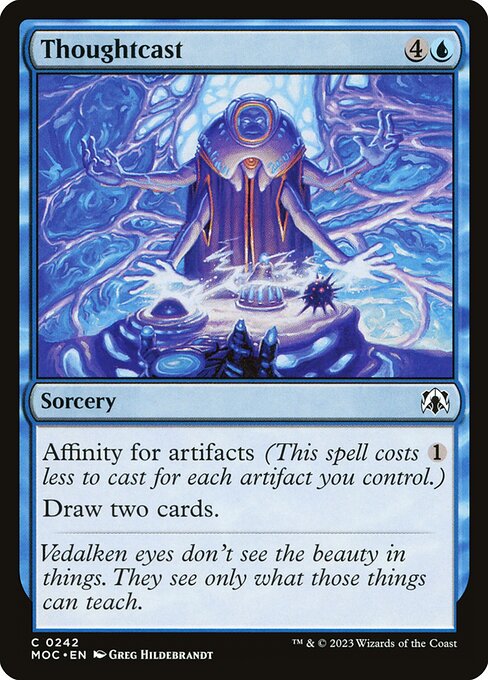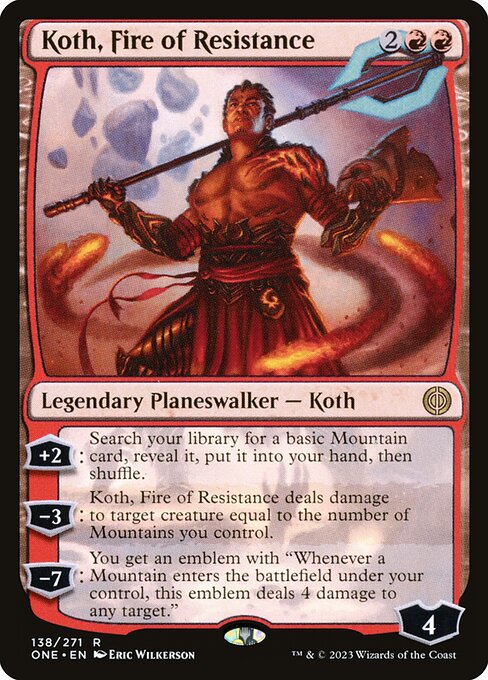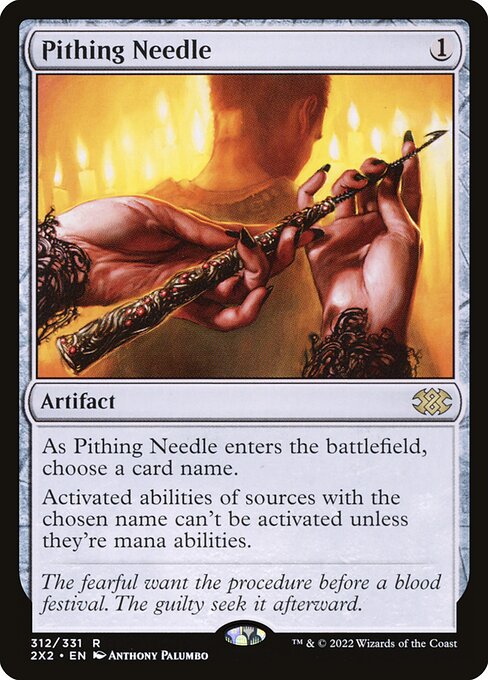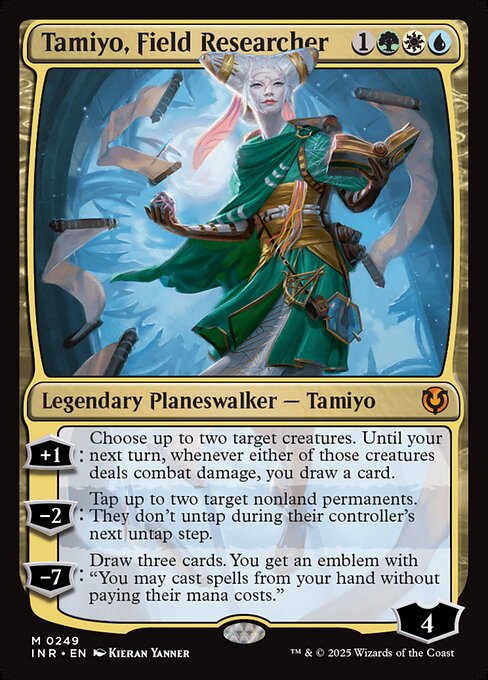With Oathbreaker’s official recognition by Wizards of the Coast, some people I play with thought it would be fun to give it a try. I put a couple decks together and played some games. I’d like to share some things about the experience and my thoughts on the format.
Building decks was tricky; I wasn’t sure what my goal should be. I have a very approximate understanding of what I should be trying to do when building a casual EDH deck, and I know precisely how to approach building a cEDH deck, but Oathbreaker’s different.
My understanding, or, more importantly, the understanding I was told by someone I’d be playing with, was the format was intended to be a way to play shorter games when you don’t have time for a full game of Commander. That’s one data point which suggests to me there’s a bit of tolerance for decks being more powerful.
The other, bigger point is you get to choose two cards, a planeswalker and an instant or sorcery. When I’m told to choose two cards, I can’t not hear it as an implication they should have some amount of synergy. If I’m starting a game with two cards in hand which have particular synergy, that’s a very strong start of a game play. The rest of my cards are probably also going to support the game plan, and I’m going to end up with a very synergistic deck. Maybe that’s a failing of imagination on my part, but I don’t know how else to approach it.

My First Steps
So how powerful am I supposed to go? That’s always the rub with these formats, right? We were all new to the format, so it’s not like I could watch games to figure out what people were trying. I figured I’d build the first things that came to mind.
My first thought was just porting my Jhoira cEDH deck to 60 cards, meaning I’d build a 60 card KCI deck. I used Saheeli, Sublime Artificer and Thoughtcast–those two have a ton of synergy because Saheeli helps me get around the commander tax on additional Thoughtcasts by giving me an additional artifact every time I cast it. I thought I could get pretty close to roughly having an emblem with U: draw two cards. The Servos could also help power KCI.
I build this. I played one game with it.
I drew very well–Turn 1, Chrome Mox imprinting something, Mox Opal, Jeweled Lotus, cast Saheeli, then cast Gitaxian Probe and Mishra’s Bauble to make two Servos. Turn 2, cast Thoughtcast twice and play Grinding Station. Turn 3, play Underworld Breach, use Mox Amber with Grinding Station and Breach to assemble a KCI loop, win.
The other deck I assembled I expected to be less powerful. It’s not exactly a casual deck because I didn’t expect it to be fun to play against–I guess you could think of it as kind of a meme deck. I played Koth, Fire of Resistance with Devastating Dreams. Most of my deck was artifact mana. My goal was to play Koth and use the +2 ability to find mountains so that I could discard to Devastating Dreams to destroy everyone else’s land. I’d keep having lands to play, thanks to Koth, and I’d draw into enough mana to cast Devastating Dreams every time my opponents got more than a few lands in play. I’d win with Koth’s Emblem.
This was my deck.

My big mistake was not including Pithing Needle and Sorcerous Spyglass. Incidentally, I think the fact that almost every deck should play those is a strike against the format–build your deck around a planeswalker, then everyone needles all of those planeswalkers so they don’t do anything–fun! One game I played my plan almost worked, another a Liliana of the Veil player kept my hand small enough so my deck didn’t work.
It seemed weird to me that Thassa’s Oracle is legal in a format where you can start every game with access to Demonic Consultation in the command zone. As a thought experiment I put together a list for Kaito Shizuki/Demonic Consultation. In this case, the text on Kaito is irrelevant except for the fact that it phases out after you play it, so it’s as likely as possible to be in play the next turn.
The list is here.
I didn’t put this together, but I figured it’d be a starting point for a competitive approach to the format.
I don’t think any of these were good or particularly ernest attempts to have as much fun with the format as possible, but I also really don’t know what that would look like.

Limitations
To me, the issue with the format, aside from the Pithing Needle dynamic, is the consistency of decks. It seems like most decks do roughly the same thing every game. Maybe you execute your plan one turn faster or slower depending on how good your draw is, but you always do basically the same thing. I think it means a given set of decks will play very similarly against each other every game.
My concern one of consistency. Casual commander has a lot of variance, and Sol Ring in particular goes a long way in giving weaker decks a big advantage when they draw it early. It allows them to punch above their weight class. Here it seems like decks are a lot less likely to line up against each other in ways that make for interesting, replayable games.
The format seems like it works better as a thought experiment than actual structure for a game of Magic.
I’ll admit there’s some amount of exaggerating the effect going on here–Magic is a very resilient game, and there’s room for these games to be interesting even if one player has a big advantage. The fact that two decks might play consistently against each other matters a lot less in a multiplayer game, and power level disparities also don’t matter as much in a multiplayer game. So it’s not really that it’s that bad, it’s just that, directionally, everything that it’s doing differently from Commander seems like a negative to me.
I don’t like to try something new and report back that others shouldn’t play it–the format’s been around for awhile, so it clearly has its supporters, but I’ve had some people ask me why Wizards decided to recognize this format in particular, and I really have no idea.

Silver Linings
So, what’s good about Oathbreaker?
60 card decks are appreciably more manageable–it’s easier to build them, both in terms of deciding which cards to play and physically acquiring and assembling them. They’re also much easier to shuffle.
Always getting to choose two cards for your command zone is an interesting thought experiment–I said the format works best as a thought experiment, and I mostly see that as a knock, but it legitimately does work pretty well as a thought experiment. For people who spend more time building decks than they do playing games, this could be a compelling space to think about decks in.
Creative expression–there are a lot of commanders in Magic, but there are way more Commander players. No matter which legend you choose, someone else has probably built that deck. Your list might be unique, but when you sit down, your opponents are often going to have an immediate reaction like, “oh, I’ve seen that”. In Oathbreaker, if you want to get creative and find a pairing no one has seen before, you can do that, and the table will instantly know your deck is doing something they haven’t played against before. The stronger and more synergistic your pairing is, the less original it’s probably going to look, but if your goal is to do something different, there’s definitely room to do so.
Moving Forward From Here
I’m not likely to return to the format. I like clear deckbuilding goals, and if I can’t have that, then I’d like to have highly variable game play. I think this format is somewhat uniquely bad at offering those two things, so it’s really not for me, but I really don’t want that to read as an attack on the format existing or implication that others shouldn’t enjoy it.
Sam Black (any) is a former professional Magic player, longtime Magic writer, host of the Drafting Archetypes podcast, and Twitch streamer. Sam is also a Commander Cube enthusiast, and you can find Sam’s cube list here. For anything else, find Sam on Twitter: @SamuelHBlack.

